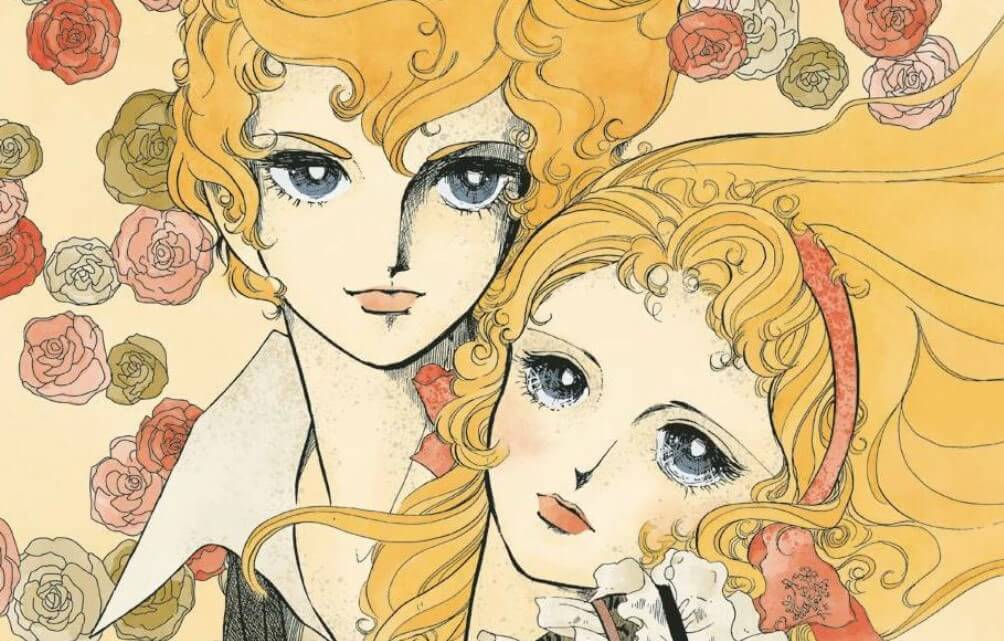“You see that old woman? That will never happen to you. You will never grow old, and you will never die.”
“And it means something else too, doesn’t it? I shall never ever grow up.”
– Interview with the Vampire
The Poe Clan Vol. 1
Moto Hagio (mangaka), Rachel Thorn (translator), Kristy Valenti (editor)
Fantagraphics Books
August 20, 2019
Once upon a time—because this is a book that demands a fairytale beginning, though the time is 1865 and the place is a vague, dreamlike Europe–a man named Glensmith hunts in the woods. Aiming his gun at what he thinks is a deer, he accidentally cuts down a beautiful young girl. Her brother Edgar arrives, furiously whisking Glensmith and the girl to a nearby village that seems to appear out of a fog. The villagers are kind but strange. They grow nothing but red roses and they never drink…wine. The mortally wounded girl miraculously heals by morning. And then in the middle of the night, Glensmith is shocked awake by Edgar drinking his blood. This is how we are introduced to the village of Poe, and the vampirnellas who live there known as the Poe Clan.
Originally serialized in 1972, The Poe Clan is a pioneering shojo manga by Moto Hagio, newly available in English and published in hardcover omnibus form by Fantagraphics. A singular vision of haunting beauty, The Poe Clan follows Edgar, his sister Marybelle (“Annabel Lee” would have been too on the nose, perhaps?), and a later companion, Alan Twilight, from the Age of Revolution through the Atomic Age. Though Edgar eventually leaves the village of Poe, he can never stay anywhere else for long, as he is trapped in eternal adolescence. The story of the vampirnellas in The Poe Clan is a beautiful fairytale for the damned.
Hagio’s artwork is a triumph of atmosphere, with graceful, balletic figures waltzing through ivy-draped mansions and dark cobblestone streets—reading The Poe Clan is like seeing a Hammer Dracula film as imagined by Aubrey Beardsley. Though vampirnellas are not traditional vampires, exactly (they don’t have fangs, instead feeding on blood and life energy through touch), they embody everything tragic and romantic about vampire legends. Let me describe a scene to you: Edgar appears in Alan’s window, his cape flying, the curtains billowing, and he offers the boy both his hand and the dark gift of immortality. (“Come. Come with me. It’s too much to bear alone.”) Even if you’ve never read the manga, I’m sure you can picture it in your mind’s eye perfectly, right down to Alan’s swoon once he’s in Edgar’s grasp.
It’s a classic vampire story, ingeniously told. One of the most interesting aspects of The Poe Clan is that Hagio focuses just as much on the humans who briefly pass through Edgar and Marybelle’s lives as the vampirnellas themselves. Some live, some die, and one troubled schoolboy provides an intriguing cliffhanger for the next volume, but all are changed. One chapter barely features the vampirnellas at all; it follows Glensmith’s diary as its drifts among his descendants, its depiction of a deathless village untouched by time bringing comfort to a family devastated by two world wars until finally it finds a way back to Edgar.
The Poe Clan is an important work in the shojo and shonen ai genres, with far-reaching influence—its childlike, rose-loving vampires were even an inspiration for a chapter of the Sailor Moon manga. Reading it in 2020, it’s also startling that its sympathetic portrayal of a vampire, the boy he loves and turns, and a little golden-haired girl vampire was published four years before Anne Rice’s Interview with the Vampire. It’s an elegiac, existential series, with the forever young, dandelion-headed Edgar ruminating: “Why do we live? I wish I knew. We create nothing. Give birth to nothing. We have no legacy to pass on to the next generation. Why do we live like this, for such long ages?” (Special mention must go to Rachel Thorn’s poetic translation; I keep coming back to Glensmith’s description of Edgar’s eyes: “Blue, like frozen stars.”)
And what does the passage of time mean to a vampire who’s lived centuries? Hagio tells her story out of chronological order, with each chapter adding a richer context to what happened before. We meet Frank and Sheila Portnell, Edgar and Marybelle’s adoptive vampirnella parents, as bored, decadent aristocrats doomed by Sheila’s adultery (she unwisely seduces a doctor, who knows how to feel for a pulse). It’s surprisingly bittersweet, then, when Hagio shows their beginnings as idealistic lovers, with Sheila making that ultimate conversion for her husband. One significant character’s full story—how they were saved by the village of Poe after being abandoned as a child, and how they became a vampirnella—is told only after we see their shocking death. What Hagio does in The Poe Clan is, in effect, an act of vampirism; she raises the dead.



